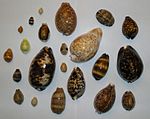- Cowrie-shell divination
-
Cowrie shell divination refers to several distinct form of divination using cowrie shells that are part of the rituals and religious beliefs of several religions. Though most well-documented in West Africa as well as in West African derived Afro-American religions, such as Candomblé and Umbanda[1][2][3], forms of cowrie-shell divination have been documented in other regions, including East Africa and India [4].
Contents
In West Africa
Several forms of cowrie-shell divination are distributed broadly throughout West Africa.
In West African Diaspora Religion
Forms using sixteen cowries
While there are many variants using from 8 to 21 cowrie shells, West African derived forms most commonly use 16 cowrie shells on a prepared table or on the ground, interpreting the patterns that result. Before each throw, the practitioner invokes and salutes the Orishas, and poses questions to them. It is believed that the Orishas answer the questions by influencing the way the shells fall on the table.
Forms of West African cowrie-shell divination are found in Brazil, Cuba, and Puerto Rico where they play an important role in religions like Candomblé and Santeria. Most of these are closely related to Ifá and employ 16 cowries.
In Brazil, it is called jogo de búzios (Portuguese for "cowrie game") or merindinlogun (Yoruba for "sixteen") by its practitioners, although the two names may designate somewhat different systems.
In Cuba, it is often called Diloggun, after the Yoruba merindinlogun.[5]
Though they share a common root, Cuban and Brazilian cowrie-shell divination have subsequently developed in partial independence from West African practice and each other. For example, among Cuban diviners, the shells are more often thrown twice to derive a composite odu in closer approximation to the practices of Ifá.
Relationship to Ifá
Cowrie-shell divination is derived from the Ifá divination practiced by Yoruba priests in Africa. However, Ifá uses palm seeds instead of shells, and different ways to "throw" and count them. Also, cowrie-shell divination is widely practiced in the Americas by women, whereas Ifá divination in Africa is traditionally reserved to men.
The practice of Ifá divination was brought to the Americas with the slave trade, mainly between the 17th and 19th centuries. The use of cowrie shells however is claimed to have come from the Middle East, and to have entered Africa some centuries earlier. Cowrie shells, which were used as currency in Africa by the time of the slave trade, are frequently used in ornaments and dresses associated with the Afro-American cults.
Divination ritual in Afro-Brazilian religions
The cowrie shell, as collected from a beach, has a flattened side with a longitudinal slit, and a smooth rounded side. Like a coin, the shell has only two stable positions on a flat surface, with the slit side facing either up or down. A few cowrie-shell diviners use the shells in this natural state; then the outcome of the throw, for each piece, is either "open" (slit up) or "closed" (slit down).
Most priests, however, use modified shells whose rounded part has been ground away, creating a second, artificial opening. The two stable positions of the shell are still called "open" or "closed" for divination purposes. In most candomblé houses (temples), "open" still means that the natural opening is facing up; but some traditions (mainly in the Candomblé Ketu sect) use the opposite convention.
The number of "open" shells is used to select an item (odú, which are the same as the principal list of Ifá divination) which direct the diviner to a fixed list of oracular verses (ẹsẹ).
References
- ^ Pierre Fatumbi Verger (1954): Dieux D'Afrique Paul Hartmann, Paris (1st edition, 1954; 2nd edition, 1995). 400 pages, 160 photos, ISBN 2-909571-13-0.
- ^ Pierre Verger, Notas Sobre o Culto aos Orixás e Voduns. 624 ages. Portuguese translation by Carlos E. M. Moura. Editora da Universidade de São Paulo, Brazil, 1999 ISBN 85-314-0475-4
- ^ José Beniste (1999), Jogo de Búzios - Um Encontro com o Desconhecido. Editora Bertrand Brasil, 290 pages. ISBN 8528607747
- ^ J. Wilfrid Jackson (1917). Shells as Evidence of the Migrations of Early Culture. London: Longmans, Green, & Co. (pp. 144-45, 170)
- ^ Ocha ni'lele (2003). The Diloggun: The Orishas, Sacrifices, Proverbs, and Prohibitions of Cuban Santeria. Destiny Books.
External links
Categories:
Wikimedia Foundation. 2010.




